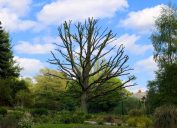6 Common Plants That May Be Banned in Your State
Several states have laws about the sale and control of invasive varieties.
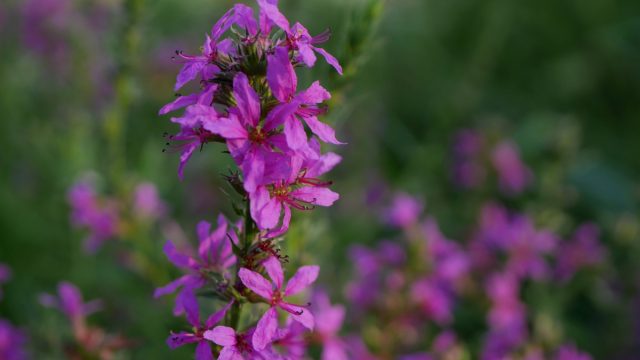
Even if you don't consider yourself an expert gardener, you still want your yard to look and feel well-manicured. To accomplish this, you may shop for plants at your local garden center, but before you solidify the vibe and vision you're going for, you should be aware of common plants that may be banned in your state.
According to Charles van Rees, PhD, conservation scientist, naturalist, and founder of the Gulo in Nature blog, the only plants that are generally banned nationwide are those that can be used to make drugs (think peyote and opium poppy). But other plants are banned on a state-by-state basis because they're designated as invasive species.
"This means that they have been introduced to North America, purposefully or otherwise, and also have negative impacts on the surrounding environment," van Rees explains. "This is typically because they are able to outcompete native species and take over wild outdoor environments, disrupting their functioning as natural ecosystems. This has negative impacts throughout wildlife communities, negatively affecting many species by reducing the amount of available food or habitat for them."
Van Rees notes that while some of the "really bad" invasive plants are being banned incrementally, they're often still available to purchase at stores—even in states with active bans in place.
"Enforcement is nearly zero," he says. "There seems to be better enforcement for weeds that cause harm to farmers' crops, but homeowners are less likely to run into these plants, since they aren't typical for gardening."
Each state has its own parameters regarding "bans," including restrictions on planting, buying, selling, distributing, and transporting these plants. So, if you're doing some work in your yard, you'll want to be wary of certain plant species. (And note their scientific names, as van Rees points out that several plants have multiple names, which can lead to confusion.) Read on for six common varieties that are banned in several states.
READ THIS NEXT: 5 Invasive Trees You Need to Remove From Your Yard Immediately.
1
Japanese knotweed (Fallopia japonica)
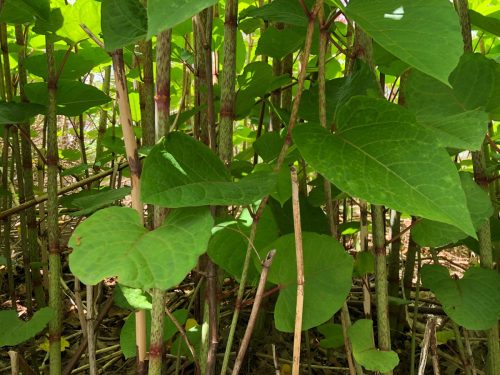
Japanese knotweed was first introduced to the U.S. in the late 1800s as an ornamental option, and it's still planted by gardeners who are "unaware of the damage it can cause," according to the National Park Service (NPS).
"Its aggressive growth can cause damage to infrastructure, disrupt natural habitats, and outcompete native plant species," Gene Caballero, co-founder of GreenPal, tells Best Life.
According to the Michigan Invasive Species website, Japanese knotweed is present in most parts of the contiguous U.S., except for Florida, Alabama, Texas, New Mexico, Arizona, Nevada, Wyoming, and North Dakota.
As of now, Washington, Oregon, Vermont, Connecticut, Massachusetts, Michigan, Minnesota, and New Hampshire are among the states that have bans in place for this "noxious weed."
2
Kudzu (Pueraria montana)
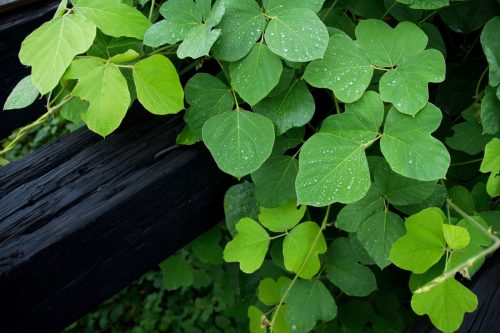
Kudzu is another common invasive that crowds out native species. According to van Rees, it's even been called "the plant that ate the South."
"It has beautiful, pleasant-smelling flowers and no doubt makes a great trellis-climbing vine, but it spreads so quickly and aggressively that it now covers the majority of forest edge in the Southeast. I mean, it really took over. And there's not much hope of getting rid of it," van Rees says.
Because kudzu outcompetes native plants, it also impacts insects, birds, and other species. Like other invasive species, kudzu can "take over places that we want to keep wild (like nature reserves and parks) and make them uninhabitable for wildlife," van Rees says.
And the economic impact can be even more dire: According to van Rees, managing these plants can cost "millions of dollars or more."
The vine is prohibited in states such as Texas, Massachusetts (under the Prohibited Plant List), New York (under New York's Environmental Conservation Law), Washington, and Ohio.
READ THIS NEXT: 7 Plants You Can Buy That Are Actually Dangerous Invasive Species.
3
Multiflora rose (Rosa multiflora)
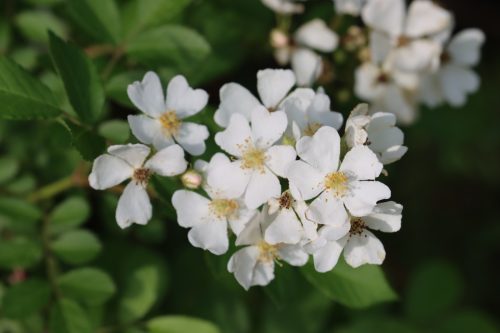
Don't be fooled by these pretty white flowers—multiflora rose is another invasive that's banned in several states. According to NISIC, this plant is able to form "dense thickets that invade pastures and crowd out native species."
It's been dubbed a noxious weed in Minnesota, and it's also illegal to sell in Maine. In addition, according to the New York Invasive Species Information website, multiflora rose is "classified as either a noxious weed, prohibited invasive species or banned, in 13 states, including Connecticut, Massachusetts, New Hampshire, New Jersey, and Pennsylvania."
4
English ivy (Hedera helix)
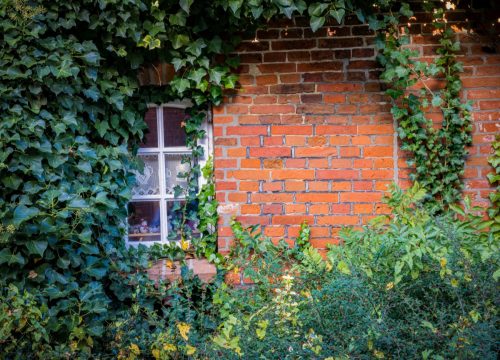
You may not realize it, but if you have ivy covering parts of your home or yard, it may very well be English ivy, which is another invasive species. It grows across landscaped areas—and it's able to thrive in a range of light and soil conditions.
This invasive can grow beyond gardens and "shade-out" other vegetation—even killing trees by working its way to the top and "dominating the canopy."
The sale of English is ivy currently prohibited in states like Oregon and Virginia.
5
Purple loosestrife (Lythum salicaria)

One of the more pervasive invasive plants is purple loosestrife. According to the Minnesota Department of Natural Resources, the purple floral plant is not permitted to be sold in most U.S. states "due to its negative impacts on plants and its ability to escape from cultivation."
As Caballero explains, "This invasive species can overtake wetland ecosystems, reducing biodiversity and altering the natural balance of these habitats."
In addition to Michigan, laws surrounding purple loosestrife are active in Indiana, Iowa, New Hampshire, Massachusetts, Washington, Illinois, and Wisconsin, to name a few.
For more important info delivered straight to your inbox, sign up for our daily newsletter.
6
Giant hogweed (Heracleum mantegazzianum)
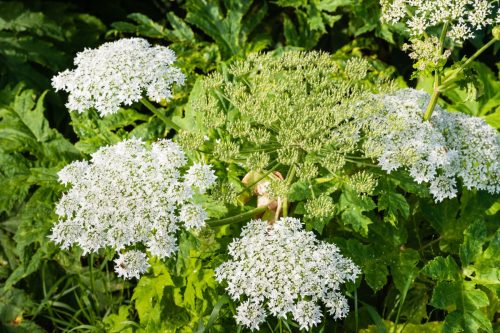
While you probably won't be seeking out giant hogweed for your garden, it's another prolific invasive you should be aware of regardless: Instead of just posing a threat to surrounding wildlife, it also poses a danger to humans. According to NISIC, this invasive "produces toxic sap that can cause skin irritation and blindness."
"Giant hogweed is prohibited in several states, such as New York, Pennsylvania, and Virginia, due to the severe health risks it poses," Caballero says. "Contact with its sap can lead to serious skin burns and blisters when exposed to sunlight."
Ben McInerney, founder at Home Garden Guides, adds that Massachusetts and Michigan also have bans, as do Wisconsin, New Hampshire, and Washington.
This invasive is also prohibited under federal law, as it's included on the Federal Noxious Weed List under the Plant Protection Act. According to the USDA, it's illegal to import or transport giant hogweed between U.S. states without a permit.
- Source: https://www.nps.gov/articles/000/japanese-knotweed-acadia.htm
- Source: https://www.michigan.gov/invasives/id-report/plants/shrubs/japanese-knotweed
- Source: https://www.nwcb.wa.gov/weeds/japanese-knotweed
- Source: https://vtfishandwildlife.com/learn-more/landowner-resources/liep-invasive-species-program/terrestrial-invasive-plants/japanese-knotweed
- Source: https://www.cga.ct.gov/2004/act/pa/2004pa-00203-r00sb-00547-pa.htm
- Source: https://www.mass.gov/service-details/massachusetts-prohibited-plant-list
- Source: https://www.mda.state.mn.us/plants/pestmanagement/weedcontrol/noxiouslist/knotweed
- Source: https://www.agriculture.nh.gov/publications-forms/documents/japanese-knotweed-bmps.pdf
- Source: https://www.mass.gov/service-details/massachusetts-prohibited-plant-list
- Source: https://nyis.info/invasive_species/kudzu/
- Source: https://www.registerofohio.state.oh.us/pdfs/901/5/30/901$5-30-01_PH_FF_N_RU_20171228_1105.pdf
- Source: https://www.invasivespeciesinfo.gov/terrestrial/plants/multiflora-rose
- Source: https://content.govdelivery.com/accounts/MEDACF/bulletins/2f7a2ea
- Source: https://nyis.info/invasive_species/multiflora-rose/
- Source: https://www.nwcb.wa.gov/weeds/english-ivy
- Source: https://wildlife.ca.gov/Conservation/Plants/Dont-Plant-Me/English-Ivy
- Source: https://extension.oregonstate.edu/ask-extension/featured/english-ivy-harmful
- Source: https://www.audubonva.org/news/virginia-general-assembly-passes-two-bills-to-deter-invasive-plants
- Source: https://www.in.gov/dnr/entomology/regulatory-information/purple-loosestrife/
- Source: https://hortnews.extension.iastate.edu/2001/6-22-2001/noloosestrife.html
- Source: https://www.des.nh.gov/sites/g/files/ehbemt341/files/documents/2020-01/bb-45.pdf
- Source: https://www.nps.gov/lowe/learn/nature/purpleloosestrife.htm
- Source: https://www.nps.gov/lowe/learn/nature/purpleloosestrife.htm
- Source: https://www.invasivespeciesinfo.gov/terrestrial/plants/giant-hogweed
- Source: https://www.aphis.usda.gov/plant_health/plant_pest_info/weeds/downloads/weedlist.pdf
